In this issue:
- Director’s Corner
- Using Mirror Nuclei to Obtain a Sharper Image of the Neutron
- First light with the Eos Hybrid Neutrino Detector
- A Bayesian approach to free-moving radiation mapping with a single detector
- Psychological Safety
- Fragments
-
Director’s Corner
It was wonderful to learn that Alan Poon is among five Berkeley Lab researchers elected into the 2023 class of the American Association for the Advancement of Science. Heartfelt congratulations to Alan and all 2023 AAAS fellows.
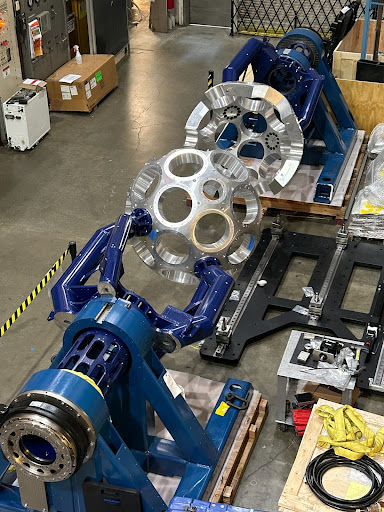
It has been a busy spring with many exciting activities at the Lab and beyond involving NSD team members. The first of several runs to demonstrate the production of element 116 with a 50Ti beam was completed with stable high-intensity beam delivery from the VENUS ion source and the 88-Inch Cyclotron and smooth operation of all experimental systems. Further runs are scheduled through June and the results will tell us if superheavy element production with Ti beam is feasible. The Eos neutrino detector, an innovative prototype for non-proliferation as well as fundamental physics research constructed on UC Berkeley campus and featured in this newsletter, saw first light. Also, the GRETA team has further advanced the project assembly and integration and successfully completed a Director’s review as well as the annual DOE/OPA Status Review of the project in April. It is very exciting to see the project visibly come together (see Fig.).
In this issue of the NSD Newsletter we also learn about how one can learn more about important properties of the neutron, such as its magnetic form factor, by studying light mirror nuclei 3He and 3H. The Newsletter also features exciting advances in radiation mapping by applying a novel Bayesian algorithm to data from a single, free-moving detector to enable reliable image reconstruction, significantly enhancing the efficient radiation imaging of large areas with important applications in nuclear safety and security.
It is inspiring to see the many facets of the research carried out and enabled by the NSD team. At the same time it is important to ensure that we foster a safe work environment, not only physically safe but also providing the psychological safety that allows for being vulnerable and for interpersonal risk taking, overall leading to a more collaborative, inclusive, and productive workplace. NSD efforts to raise awareness around this topic with support from the Lab’s IDEA office are also featured in this issue.
Overall, I am thrilled to see these science and technology developments as well as the advancement of our workplace culture.
Sincerely,

-
Using Mirror Nuclei to Obtain a Sharper Image of the Neutron
Elastic electron-neutron (e-n) scattering provides access to the neutron form factors which, when precisely measured over a range of energy scales, Q2, provide access to the spatial distribution of the charge and magnetization within the neutron. However, neutrons are only stable when bound in nuclei, making it challenging to cleanly measure scattering from a single neutron. Several techniques have been used to try and extract the form factors by isolating e-n scattering from a neutron bound in a deuteron (proton + neutron) from the dominant e-p contribution and then applying corrections for the fact that the neutron is bound in the nucleus. Modern measurements have enabled extractions with modest corrections, but yield inconsistent results between different experimental techniques [1].
A recent program at Jefferson Lab compared scattering from 3H and 3He [2]. This has two major advantages: the 3H-3He scattering difference is directly related to the difference between the proton and neutron contributions and the corrections associated with being bound in these nuclei are essentially identical due to isospin symmetry of these mirror nuclei. Data measuring quasielastic scattering (single nucleon knockout) was used to measure the neutron cross section relative to the well known proton cross section, allowing for an extraction of the neutron magnetic form factor [3]. These results overlapped with several previous measurements, including in the region where previous measurements showed systematic disagreement.
A global analysis of these measurements yields an extraction of the form factor that is consistent with the individual measurements if one allows for the possibility of small (1.5%) rescaling of the individual data sets. Such correlated uncertainties were not evaluated for most of these measurements, but these small adjustments are consistent with our estimate of such effects for the earlier measurements. Because our new data overlapped with multiple experiments, it will help determine the relative corrections for previous data sets. We are now using these new results to provide an updated evaluation of the neutron form factor and to examine the impact of these results on the spatial distribution of magnetization in the neutron.
Figure 1: The extracted neutron form factor from the 3H-3He comparison (red squares) compared to earlier measurements using a variety of different techniques.
This experiment was proposed by John Arrington and collaborators, and the data included in this paper included the PhD thesis results of RNC staff member Shujie Li, former RNC postdoc Rey Cruz-Torres, and Nathaly Santiesteban (assistant professor at UNH). The ongoing global fitting and spatial structure studies being carried out by JA, TH, NS, and her undergraduate student, Joe Jayne.
References
[1] Z. Ye and J. Arrington, Phys. Lett. B 777 (2018) 8
[2] J. Arrington, R. Cruz-Torres, T. J. Hague, L. Kurbani, S. Li, D. Meekins, and N. Santiesteban, Eur. Phys. J. A 59 (2023) 8, 188
[3] S. N. Santiesteban, Phys. Rev. Lett. (2024), arXiv:2304.13770 -
First light with the Eos Hybrid Neutrino Detector
In March, the Eos collaboration hit a major milestone in their development of a novel “hybrid” neutrino detector which simultaneously leverages both Cherenkov and scintillation signatures.
Eos is a 3.5-meter tall, 3-meter wide cylinder, ultimately to be filled with water and an organic scintillator surrounded by highly sensitive Photomultiplier Tubes (PMTs). By combining Cherenkov and scintillation emission the detector has the potential to provide greater sensitivity and resolution than conventional detectors. These improvements could be a game-changer for future neutrino physics experiments while also providing new capabilities for nuclear non-proliferation.
On the 8th March 2024 the detector saw its first light. By injecting blue LED flashes into Eos using its light injection calibration system, the PMTs were able to observe pulses in the single photon regime. This moment represented the culmination of effort from the entire collaboration, demonstrating the integration of many critical subcomponents of this next-generation neutrino detector.
This event proved to be ideally timed, with the results coming just weeks before the Eos Collaboration Meeting which ran from the 21st to 22nd March allowing the results of this landmark to be presented to the entire team. The observation indicates that the detector is functioning as expected, and will now imminently move into the next stage of its development – filling with water.
The water fill will provide an essential period for the Eos team to fully understand the detector performance, test its modeling, and scrutinize its reconstruction techniques through the deployment of an array of calibration sources. At this point, the team will be ready to inject Water based Liquid Scintillator into Eos’ central acrylic volume. Through the further deployment of radioactive sources, the Eos collaboration will be able to fully understand this novel neutrino detection medium. Eos aims to demonstrate the capabilities that the latest fast photosensors, combined with high photocathode coverage, and the use of dichroicons in spectral photon sorting will have in separating Cherenkov and scintillation emission from WbLS. In doing this, Eos hopes to illustrate the advantages of this “hybrid” detection for many future neutrino applications. This will be an exciting moment: Eos’ performance this year can demonstrate a bright future for these novel techniques. The scope of possibilities are vast, from using Eos itself in nuclear nonproliferation experimentation to scaling up the technology to experiments such as the proposed Theia to apply these techniques in the search for the fundamental nature of neutrinos.
The Eos collaboration is led by NSD Faculty Scientist Gabriel Orebi Gann.
Figure 1: Preliminary Eos event display of a commissioning run. Here light was injected between columns 16 and 17 of the side PMTs. The resulting detected light can clearly be seen by the PMT array on the opposite side of the detector.
-
A Bayesian approach to free-moving radiation mapping with a single detector
Large-area radiation imaging is crucial in enhancing nuclear safety and security. Traditional mapping methods involve stationary gamma-ray detectors or imagers and necessitate multiple time-consuming static measurements at various locations.
To overcome this limitation, researchers with NSD’s Applied Nuclear Physics (ANP) program have previously introduced a new radiation imaging concept named Scene Data Fusion (SDF) [1] which enables free-moving, 3-D radiation imaging by combining conventional radiation imaging systems with contextual sensors such as video and LiDAR. Researchers have recently demonstrated new, advanced algorithms to allow the SDF concept to be more readily applied to imaging and mapping with single detectors rather than gamma-ray imagers. In single-detector mapping, variations in count rate data recorded from a free-moving detector are reconstructed into a radioactivity map. Although the concept is promising, the lack of reliable image reconstruction algorithms had previously been a limiting factor, as the conventional maximum likelihood estimation (MLE) based image reconstruction approaches are prone to overfitting.
To tackle this problem, ANP researchers, in collaboration with Jaewon Lee, a graduate student at UC Berkeley who has been leading this work, have recently developed a novel Bayesian image reconstruction algorithm based on Gaussian process priors. The approach can combat the overfitting problem of the MLE, and provide Bayesian uncertainty quantification capabilities using Bayesian posterior approximation techniques, such as the Markov Chain Monte Carlo (MCMC) algorithm and the Laplace approximation. Uncertainty quantification provides highly useful information for a variety of radiological search activities.
Furthermore, the algorithm can be extended to decompose a time series of radiation spectra collected from a single detector into constituent background and source spectral components, along with the spatial distributions of these components. This approach was demonstrated with data collected at the Savannah River National Laboratory (SRNL) H-area, where an unknown amount of 137Cs contamination is present. Despite the very low 137Cs count rates recorded (<10 cps) compared to the background (~400 cps), the algorithm successfully recovered a deposition map, along with the corresponding 137Cs and background spectral features. Additionally, the uncertainties were measured in the reconstructed deposition map and the spectral components, providing valuable information for future measurement planning. The reconstructed 137Cs activity and uncertainty maps are shown in Fig. 1 and the decomposed spectral components are shown in Fig. 2.
The ANP plans to broaden the algorithm’s application to encompass a wide array of radiation imaging problems, where uncertainty quantification is indispensable, such as Targeted Alpha Therapy (TAT) radiopharmaceutical imaging and radiation dose mapping inside the Chernobyl nuclear power plant’s new safe confinement. This promises a significant advancement in the field of radiation imaging.
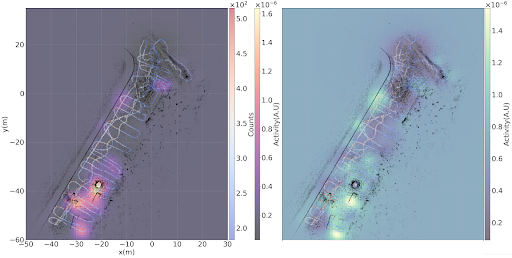
Figure 1: (Left) The reconstructed image of Cs-137 activity distribution at the SRNL H-area. The measurement path along with the LiDAR point clouds are superimposed on the reconstructed activity map. Notice that the radiation background contribution changes dynamically, ranging from 200 to 500 cps. (Right) The corresponding pixelwise Bayesian uncertainty map (90% credible intervals) from the Laplace approximation.
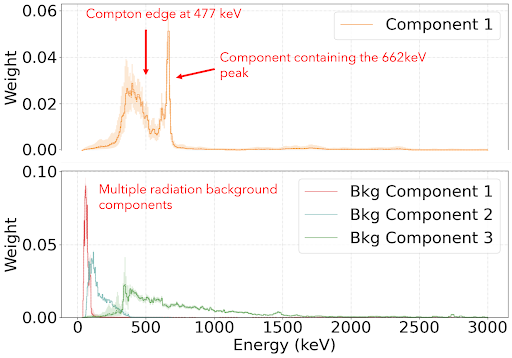
Figure 2: (Top) The source spectral component reconstructed from the measurement at the SRNL H-area. Notice the photopeak at 662 keV and the Compton edge at 477 keV, hallmarks of a Cs-137 gamma-ray spectrum. The shaded region represents the 90% Bayesian credible intervals. (Bottom) The background spectral components recovered from the measurement. The dynamically changing background contribution can be effectively modeled by the linear combination of the three background components recovered.
References
[1] D. Hellfeld, et al, “Free-moving quantitative gamma-ray imaging,” Sci. Rep. 11 20515 (2021), https://doi.org/10.1038/s41598-021-99588-z -
Inclusion, Diversity, Equity and Accountability Moments

Psychological Safety
At the Nuclear Science Division staff meeting on Tuesday, January 23, Janie Pinterits and Kelly Perce from the lab’s IDEA Office gave a presentation about psychological safety. Psychological safety is defined by Amy Edmondson of Harvard Business School as “the shared belief that the team is safe for interpersonal risk-taking” and is something we would like to foster in NSD. We believe that the best science is done when all members feel encouraged to openly share ideas and bring up difficult topics without fear of embarrassment or rejection so we can grow and learn from our mistakes together.
They led the attendees through an exercise where they broke us into small groups to discuss two scenarios. Both involved situations where a less experienced person’s attempts to contribute were dismissed by a more senior colleague — a psychologically unsafe situation — and we were tasked with brainstorming how to respond or intervene in a way that enhanced psychological safety for the junior colleague. We then rejoined as a group and shared our thoughts.
As Janie and Kelly shared in their slides, the goal of increasing psychological safety requires us all to maintain an environment of civility and respect, to actively listen to one another, to express and be inclusive of each other’s work preferences, and to give and accept feedback well. We also have to accept that we will have to continually work on this goal without expecting to reach a “steady state.”
Figure 1: An illustration that Janie and Kelly shared of how psychological safety and danger exist as self-reinforcing feedback cycles. Here is a list of resources that Janie and Kelly shared with us for further learning:
- LBL IDEA Office: How to foster Psychological Safety on your teams
- LBL IDEAs-in-Action: Psychological Safety in the workplace
- LBL IDEAs-in-Action: Creating a culture of feedback
- LBL IDEAS-in-Action: Allyship
- LinkedIn Learning: Psychological Safety: Clear Blocks to Innovation, Collaboration, and Risk-Taking
- NIH Record: Workplace Civility Increases Productivity
- Harvard Business Review: Make civility the norm on your team
We hope to continue this conversation in the coming weeks and months as we explore this approach to making our workplace more inclusive. Thank you all for your efforts and engagement.
-
Fragments
It is with deep sadness that we note the recent passing of retired NSD scientists Doug Greiner and Joe Cerny.
Doug Greiner will be remembered as a pioneer of experimental relativistic heavy-ion collisions, having worked on many key early experiments, including HISS at the Bevalac and NA-36 at CERN, before retiring in 1993. He had a particular interest in strangeness production in these collisions, having made early measurements of lambda production in sulfur-sulfur and sulfur-silver collisions. After retirement, Doug returned to the lab part-time, where he helped out with the construction of the STAR time projection chamber. Our thoughts are with his family, including his son Leo Greiner, who recently retired from the RNC program, and daughter-in-law Eleanor Judd, who works at Space Sciences Laboratory on the STAR detector trigger.
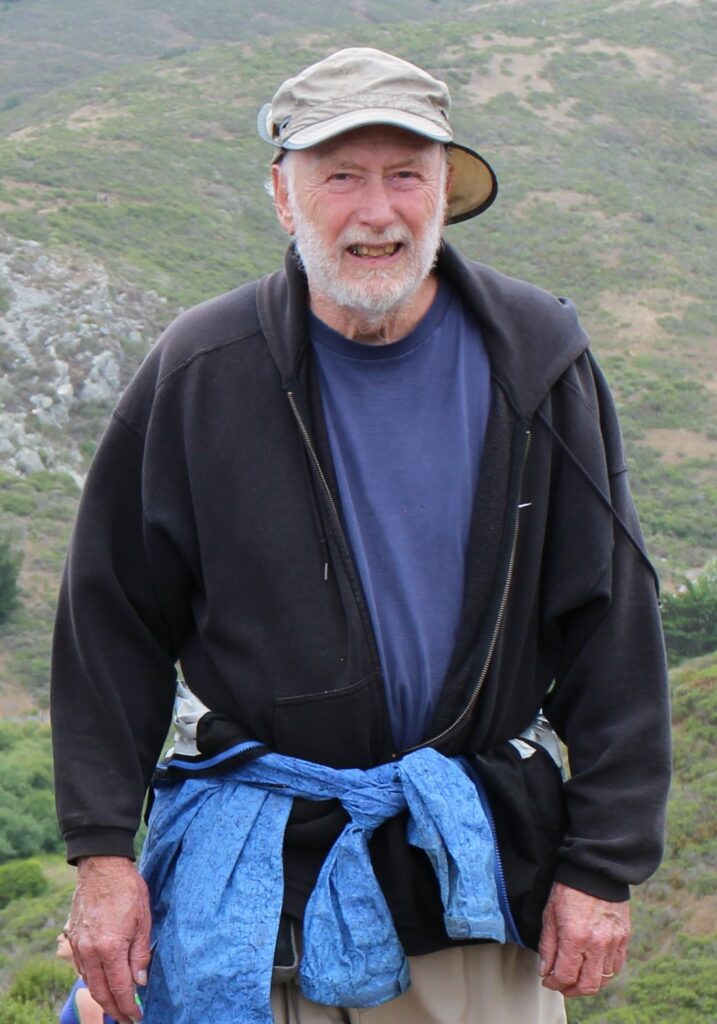
Joe Cerny will be remembered for his more than half a century of research and leadership at Berkeley Lab and UC Berkeley. Before retiring in 2013 he was the former Division Director of the Nuclear Science Division and Associate Laboratory Director at Berkeley Lab, as well as Professor of Chemistry and former Chemistry Department chair, Graduate Division Dean, and Provost and Vice Chancellor for Research at UC Berkeley. He will be remembered for many notable achievements, including the Ernest Orlando Lawrence Memorial Award of the Atomic Energy Commission (predecessor of the U.S. Department of Energy) in 1974, for his “discovery of proton emission as a mode of radioactive decay, for investigation of the limits of nuclear stability of a number of light elements” – and, significantly – “for ingenious instruments that made these discoveries possible.”
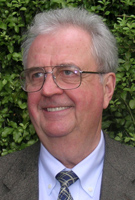
Several NSD staff members and affiliates attended the April Meeting of the American Physical Society which was held in Sacramento during the first week of April where they delivered presentations on a range of topics.
NSD’s Alan Poon, the head of the Neutrinos Program, has been named a Fellow of the American Association for the Advancement of Science. Alan has been recognized for his “important contributions towards the understanding of neutrino properties in search of physics beyond the Standard Model of particle physics.” Further details can be found here. Congratulations to Alan on this well-deserved award!
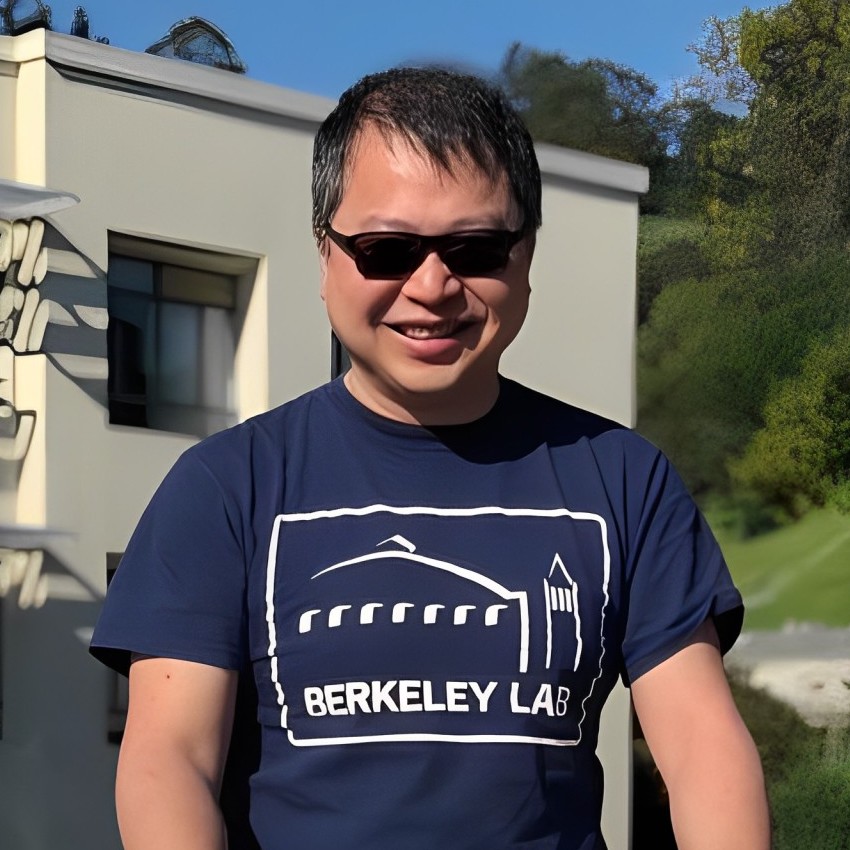
NSD celebrates several recent promotions. Heather Crawford was promoted to Senior Scientist, and Lee Bernstein was promoted to Faculty Senior Scientist. After open searches, Weronika Wolszczak was promoted to Research Scientist, and Emil Rofors was promoted to Career Track Research Scientist.
Congratulations also go to Carol Chien who celebrates 10 years of service at LBNL!
-
Sign up for our newsletter!